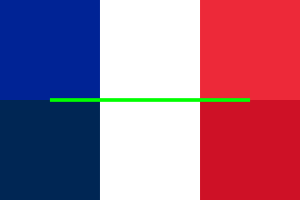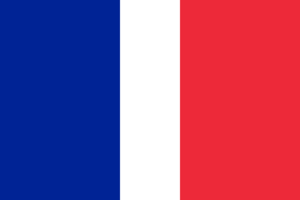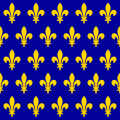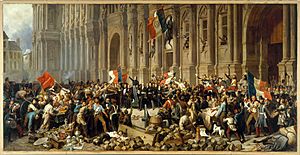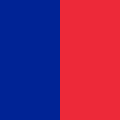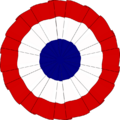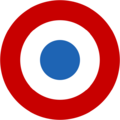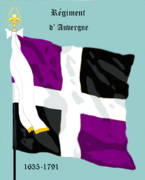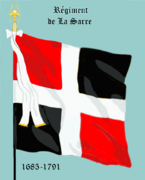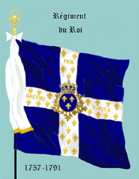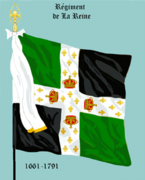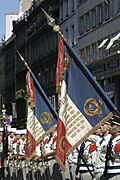Flag of France facts for kids
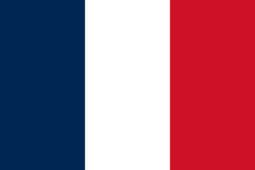 |
|
| Name | Tricolore |
|---|---|
| Use | National flag |
| Proportion | 2:3 (habitual) |
| Adopted | 15 February 1794 |
| Design | A vertical tricolour of blue, white, and red |
| Designed by | Jacques-Louis David |
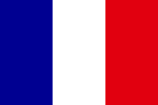
Variant flag of French Republic
|
|
| Use | National flag |
| Proportion | 2:3 (habitual) |
| Adopted | 1976 |
| Design | An interchangeable variant of the national flag with lighter shades |
The national flag of France (French: drapeau français) is also known as the Tricolour (French: Tricolore). It has three vertical stripes: blue on the hoist side (the side closest to the flagpole), white in the middle, and red on the other side.
This flag design became popular after the French Revolution. Revolutionaries were inspired by the red, white, and blue flag of the Netherlands. The French Tricolour became one of the most important flags in history. Many other countries in Europe and around the world later used a similar three-color design. It stands for freedom and change, against the old royal ways.
Before the Tricolour, French kings used many different flags. A well-known one was a white flag with gold fleurs-de-lis (a lily symbol). During the French Revolution, people in Paris wore special badges called cockades. These badges were blue and red, the traditional colors of Paris. A French general named Gilbert du Motier, Marquis de Lafayette suggested adding white. White was seen as an "ancient French color." This created the three-color badge.
This three-color badge became part of the uniform for the National Guard. The colors and design of this badge led to the Tricolour flag. It was first adopted in 1790. The original design had red closest to the flagpole. A new design by Jacques-Louis David was adopted in 1794, with blue closest to the flagpole. The royal white flag was used again from 1815 to 1830. But the Tricolour returned after the July Revolution in 1830 and has been used ever since.
Since 1976, there have been two versions of the flag. One uses a darker navy blue, and the other uses a lighter blue. Since July 2020, France has mostly used the older, darker blue version. This includes at the official residence of the French President, the Élysée Palace.
Contents
Flag Design and Colors
Article 2 of the French constitution from 1958 says that "the national emblem is the tricolour flag, blue, white, red." The law does not say exactly what shades of these colors should be used.
The blue stripe has usually been a dark navy blue. A lighter blue (and slightly lighter red) version was introduced in 1976. This was done by President Valéry Giscard d'Estaing. Both versions were used for a while. Town halls, public buildings, and army bases often fly the darker flag. But the lighter version was sometimes used on official government buildings.
On July 13, 2020, President Emmanuel Macron decided to go back to the darker blue. He did not make a big announcement or order other places to change. This change for the presidential Élysée Palace was a symbol of the French Revolution. People had different opinions about the change. But it was noted that both dark and light flags had been used for many years.
The flag is usually one and a half times wider than its height (a 2:3 ratio). The stripes are normally of equal width. However, in the French Navy, the stripes are not equally wide. They are in the proportions 30 (blue), 33 (white), and 37 (red). This is because when a flag flaps in the wind, the parts farther from the flagpole can look smaller. So, the navy makes those parts wider so they appear equal.
When the French president or prime minister is being photographed, a flag with a narrower white stripe is often used. This is so that all three stripes are clearly visible in the camera's view. If the stripes were equal, the camera might only show the white stripe.
What the Colors Mean
Blue and red are the traditional colors of Paris. They are used on the city's coat of arms. Blue is linked to Saint Martin, and red to Saint Denis. During the storming of the Bastille in 1789, people in Paris wore blue and red badges. White had been on French flags for a long time. General Lafayette called it the "ancient French color." White was added to the blue and red to make the design "national." This created the cockade of France.
Some people say Lafayette linked the white stripe to the nation. Others say it represented the monarchy. Blue and red are also connected to the Virgin Mary, who is a patron saint of France. These colors were also on the oriflamme, an old French battle flag.
The colors of the French flag might also represent the three main groups of people in the old French society (the Ancien Régime):
- The clergy (church leaders): white
- The nobility (rich landowners): red
- The bourgeoisie (middle class): blue
The blue and red colors are on each side of the white. This suggests that the white represents a higher order.

The cockade of France was adopted in July 1789. This was a time of national unity. But soon, different groups emerged. Royalists wore white badges. Revolutionaries and Socialists used the red flag. The Tricolour, which mixes royalist white with republican red, became a symbol of balance. It showed a sense of national pride that went beyond different groups.
The French government says the white part was the king's color. Blue and red were the colors of Paris.
Sometimes, the three colors are said to represent the three parts of the French Revolution's motto:
- liberté (freedom): blue
- égalité (equality): white
- fraternité (brotherhood): red
This idea was even used in a movie series called "Three Colours" by Krzysztof Kieślowski. After the November 2015 Paris attacks, many famous places and stadiums around the world were lit up in the French flag colors to honor the victims.
History of the Flag
Flags of the Kingdom of France
In the early Middle Ages, a flag called the oriflamme was used. It was red and had spikes. It was the royal banner for the Capetian kings. It was kept in a special abbey and brought out for wars. French kings would go into battle with Saint Martin's red cape or Saint Denis's red banner.
Later, these colors became linked to the ruling family of France. In 1328, the House of Valois had a blue coat-of-arms with gold fleurs-de-lis and a red border. Kings of France were often shown wearing a red gown under a blue coat with gold fleurs-de-lis. Charles V of France changed the design around 1376. Instead of many fleurs-de-lis, there were just three. These designs are known as France Ancient and France Modern.
During the Hundred Years' War, England used a red cross. Burgundy used a red X-shaped cross. France used a white cross. This white cross could be on a blue or red background. The blue background became common for French armies. French regiments later used the white cross as their standard. They added their own colors in the corners. The French flag with a white cross on a blue background is still seen on some flags today. For example, it is on the flag of Quebec.
The flag of Joan of Arc during the Hundred Years' War was white. It had lilies, a picture of the world, and an angel on each side. It also said "JHESUS MARIA" on it. Joan's flag helped make white a very important color on later French flags.
When the Bourbons became kings of France, the navy's green flag became a plain white flag. This white flag symbolized purity and royal power. Merchant ships used "the old flag of the nation of France," which was a white cross on a blue background. There was also a red flag for French galleys. Sometimes, a white flag with gold fleur-de-lis was also used by the Bourbons.
The Tricolore Flag
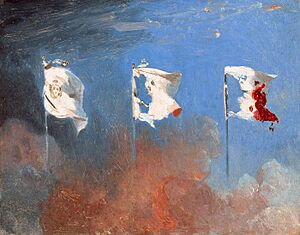
The French Tricolour flag came from the cockade of France. These were round, rosette-like badges worn on hats during the French Revolution. On July 12, 1789, Camille Desmoulins asked his followers to wear green cockades. The Paris militia, formed on July 13, chose a blue and red cockade. Blue and red are the traditional colors of Paris.
Adding white to the cockade is often linked to Lafayette or Mayor Jean Sylvain Bailly. Some even say King Louis XVI himself added it. This happened around July 17, 1789, when the king visited Paris city hall. However, it is known that the three-color cockade was already being worn by order of the city from July 13 or 14. On July 27, a three-color cockade became part of the uniform for the National Guard.
A drapeau tricolore (three-color flag) with vertical red, white, and blue stripes was approved on October 24, 1790. This simple design showed that the revolution was breaking from the past. The order of colors was changed to blue-white-red, which is the current design, on February 15, 1794.
When the Bourbon kings returned to power after Napoleon's defeat in 1815, the tricolore was replaced. They used a white flag, which was the navy flag before the revolution. But after the July Revolution of 1830, King Louis-Philippe brought back the tricolore. It has been France's national flag ever since.
After Napoleon III was overthrown, royalists were elected to the new Third Republic's National Assembly. They offered the throne to a Bourbon prince, Henri, Comte de Chambord. But he said he would only accept if the Tricolour was replaced by the white flag. Since the Tricolour had become a beloved national symbol, this demand could not be met. Plans to bring back the monarchy were stopped, and France has remained a republic with the Tricolour flag.
The Vichy régime, which ruled France during World War II, kept using the tricolore. However, their leader, Philippe Pétain, used a special flag. It had an axe symbol in the white stripe. This axe was called the "Francisque." At the same time, the Free French Forces used a tricolore with a red Cross of Lorraine in the white stripe.
The French constitutions of 1946 and 1958 officially made the "blue, white, and red" flag the national symbol of the Republic. The colors of the national flag are sometimes said to represent different flowers. Blue represents cornflowers, white represents marguerites (daisies), and red represents poppies.
-
 The French Second Republic used a different tricolour for a few days in 1848
The French Second Republic used a different tricolour for a few days in 1848 -
 A proposed flag by Henri, Count of Chambord, which he later rejected
A proposed flag by Henri, Count of Chambord, which he later rejected -
From 1912, the French Air Force used these roundels on military aircraft
-
 Personal flag of Philippe Pétain, leader of Vichy France
Personal flag of Philippe Pétain, leader of Vichy France -
 Flag used by the Free French Forces during World War II
Flag used by the Free French Forces during World War II
Regimental Flags
-
French soldiers started using white crosses during the Hundred Years' War
-
Pre-revolutionary regimental flags inspired the flag of Quebec
Colonial Flags
Most French colonies used the regular Tricolour flag or a local flag without the French flag. Here are some exceptions:
-
 Flag of Tonkin (French protectorate) and Annam in French Indochina
Flag of Tonkin (French protectorate) and Annam in French Indochina -
 Flag of French Sudan (1958–1959), now Mali
Flag of French Sudan (1958–1959), now Mali -
 Flag of French Togoland (1916–1960), now Togo
Flag of French Togoland (1916–1960), now Togo -
 Flag of Gabon (1959–1960)
Flag of Gabon (1959–1960) -

 Unofficial flag of Saint Barthélemy
Unofficial flag of Saint Barthélemy -
 Flag of New Hebrides (Vanuatu) under the Anglo-French Joint Naval Commission (1887–1906)
Flag of New Hebrides (Vanuatu) under the Anglo-French Joint Naval Commission (1887–1906) -
 Flag of the French Protectorate of Wallis and Futuna (Uvea) (1860–1886)
Flag of the French Protectorate of Wallis and Futuna (Uvea) (1860–1886) -
 Present unofficial flag of Wallis and Futuna
Present unofficial flag of Wallis and Futuna -
 Flag of the French protectorate of Rurutu in French Polynesia (1858–1889)
Flag of the French protectorate of Rurutu in French Polynesia (1858–1889) -
 Flag of French Polynesia
Flag of French Polynesia -
 Flag of the French protectorate of Saar (1947–1956)
Flag of the French protectorate of Saar (1947–1956) -
Flag of the French Southern and Antarctic Lands
-

 Unofficial flag of Louisiana (1861)
Unofficial flag of Louisiana (1861)
Flags in Canada and North America
Many areas in Canada have French-speaking communities with their own flags:
Many places in North America have large French-speaking and French-heritage communities:
-
Flag of Acadiana
-
Flag of United Franco-Americans
-
Flag of New England Franco-Americans
-
Flag of Aroostook county Franco-Americans
-
Flag of Androscoggin county Franco-Americans
-
Flag of Illinois Country Franco-Americans
-
Flag of Iowa
-
Flag of New Orleans, Louisiana
-
Flag of Mobile, Alabama
The New Hebrides (now Vanuatu) used several flags that included both the British Union Flag and the French flag.
In the Shanghai International Settlement, the flag of the Shanghai Municipal Council had a shield that included the French Tricolour.
Two areas in Vietnam used flags based on the French Tricolour.
Images for kids
See also
 In Spanish: Bandera de Francia para niños
In Spanish: Bandera de Francia para niños
- List of French flags
- Flags of the regions of France
- National emblem of France
- Armorial of France
- Cockade of France
- Flag of Madriz Department, Nicaragua, similar design
- Flag of Haiti (based on French Republican flag)


